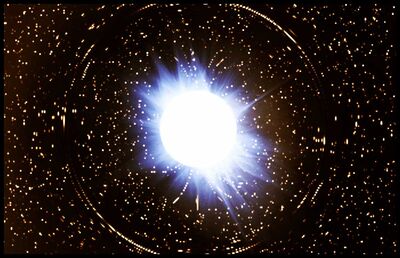A neutron star is a type of stellar remnant that can result from the gravitational collapse of a massive star during a supernova event, where the exploding star lacks to mass to become a black hole. Neutron stars are the densest and tiniest stars known to exist in the universe; although having only the radius of about 10 km (6 mi), they may have a mass of up to five times that of a Sun-sized star.
Formation
Any star with an initial main-sequence mass of around 10 solar masses or above has the potential to become a neutron star. As the star evolves away from the main sequence, subsequent nuclear burning produces an iron-rich core. When all nuclear fuel in the core has been exhausted, the core can no longer support the mass of the shell and it collapses, increasing heat and pressure until it explodes in a supernova, which ejects the outer layers of the star outward at relativistic velocities, forming nebulae such as the Xagyg Dust Nebula and the Greater Morass. The rapidly spinning remnant has the mass of 1-4 solar masses; any heavier and it continues to collapse until it becomes a black hole.
About one in twenty neutron stars form as one or both parts of a Binary Star System.
Properties
Neutron stars appear white to the naked eye,[1] and are extremely dense, with a surface gravity measured in the millions of g's.[2]
More importantly, each has a unique pulsating radio signature that is extremely useful for stellar navigation, much like the lighthouses of old.
Neutron Stars of the Frontier Sector
Within the Standard Map of the Frontier, there are six neutron stars:
- NS-H-17 - 6 LY from Gruna Garu, beyond the Greater Morass toward the Vast Expanse.
- NS-F-3 - 7 LY from Prenglar and 5 LY from Athor, this neutron star is better known as "the Eye of Yreva", because when seen from the Prenglar system, it has the Yreva Nebula's "head" as a backdrop and appears to be where a human's eye should be.
- NS-W-I - 5 LY from Capella, this neutron star figures prominently in Ifshnit literature and religion; against the backdrop of the Vast Expanse, it is the pole star of Homeworld and one of the most prominent stars in the southern skies. Frontier spacers associate it with the Formad Cluster (as seen from Prenglar) and call it "The Formad Beacon". It is also an important reference point to ships "making the bend" in the Capellan Pass.
- NS-23-L - 7 LY from K'aken-Kar and nestled within the depths of the Xagyg Dust Nebula, this is both the oldest and visually brightest neutron star in the Frontier, and its rotational period is also the slowest. Called Ch'Kak-Kar by the Vrusk, it is said that it shows the way to wealth and features on many works of fiction as the system of the legendary "treasure planet" though these are commonly discounted as hatchling's stories.
- NS-25-B - A rather unremarkable neutron star 4 LY from Solar Major, its rotational plane lies perpendicular to the line of sight of most of the Frontier. Its rotational period was first cataloged by the UPFS Eleanor Moraes expedition and registered as "Marnie's Light".
- NS-22-15 - 5 LY from Solar Minor, this rather dim (visually) but powerful (radio) neutron star has served the Frontier well as a navigational aid. Yazirians call it "the Human Beacon" because it lies in the direction of the Human-settled systems. On Minotaur, it is called "Arachne", but on Clarion it is called "Aresievo", though few have any idea why.
Notes & References
- ↑ Although they are very bright, their small size and surrounding detritus clouds make them no brighter than average when seen from light years away.
- ↑ One measure of its immense gravity is the fact that neutron stars have an escape velocity of around 100,000 km/s, about a third of the speed of light. Matter falling onto the surface of a neutron star would be accelerated to tremendous speed by the star's gravity. The force of impact would likely destroy the object's component atoms, rendering all its matter identical, in most respects, to the rest of the star.
| This page uses Creative Commons Licensed content from Wikipedia (view authors). | 
|
